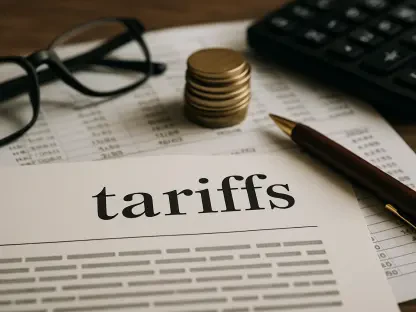As global economies brace for October’s U.S. Consumer Price Index (CPI), the U.S. dollar saw a slight decline ahead of this crucial inflation data. This drop highlights key economic indicators and political developments influencing currency markets worldwide. The Dollar Index witnessed a minor dip of 0.1% to 105.850, retreating from a recent six-month peak. For investors and policymakers, the anticipation surrounding the U.S. inflation figures remains high, as their outcomes will likely guide the Federal Reserve’s future interest rate strategies.
Economic Influences on the Dollar
Inflation Predictions and Federal Reserve Response
The U.S. Consumer Price Index (CPI) for October is set to play a pivotal role in shaping monetary policy, and economists are closely scrutinizing potential outcomes. The predictions indicate a one-year increase in headline price growth to 2.6%, while core inflation is expected to remain steady at 3.3%. These metrics will be instrumental for Federal Reserve policymakers as they map out their next steps regarding interest rates. Given the interconnected nature of global markets, shifts in U.S. inflation data resonate far beyond American shores, affecting currency values and economic decisions worldwide.
The dollar’s recent ascendancy was influenced significantly by Donald Trump’s presidential victory, which brought forth an expectation of policies that could drive inflation. Market analysts foresee that Trump’s administration might implement measures such as lowering taxes and imposing trade tariffs, both of which are considered inflationary. These anticipated changes hold the potential to further strengthen the dollar, making it an appealing option for investors looking to hedge against inflation. However, the exact trajectory remains uncertain and contingent on how these policies unfold over the coming months.
European Political Uncertainty and Its Impact
Political developments on the other side of the Atlantic also have a considerable bearing on currency markets. In Europe, particularly in Germany, a wave of uncertainty has arisen following the collapse of Chancellor Olaf Scholz’s coalition, leading to a snap election scheduled for February 23. This political instability has exerted pressure on the euro, which traded at 1.0627, nearing a one-year low. Adding to the euro’s woes are looming concerns about potential tariffs that the Trump administration might impose, further unsettling the European economic landscape.
The European Central Bank’s (ECB) potential response to these pressures is crucial. Market expectations suggest that the ECB might cut rates more aggressively compared to the Federal Reserve, particularly to counter the tariffs’ economic repercussions. Such a move could further weaken the euro against the dollar. Analysts are keeping a watchful eye on how these political and economic developments interplay, with many forecasting significant shifts in the euro’s valuation in the near future. The evolving scenario underscores the complex and dynamic nature of currency markets, influenced by a myriad of factors ranging from domestic policy shifts to international geopolitical events.
Impact on Other Major Currencies
Sterling and Its Monetary Outlook
Turning to the British pound, sterling showed a slight uptick, trading at 1.2750. This movement can be attributed to the Bank of England’s recent interest rate cut, which aims at stimulating the economy amid challenging conditions. Moreover, market participants are keenly awaiting insights from Catherine Mann, a prominent member of the Monetary Policy Committee, who is expected to speak on the latest budget’s implications for monetary policy. Her viewpoints will be particularly relevant in understanding how rising unemployment and wage figures might shape future economic strategies.
Investors and traders are poised to analyze Mann’s comments thoroughly, as they seek to grasp the Bank of England’s approach to navigating the current financial landscape. The interplay between fiscal policies, labor market dynamics, and monetary interventions remains critically important. Sterling’s trajectory will largely depend on how these factors align and the resulting confidence levels among investors. With the U.K. economy facing multiple headwinds, the policymaking discourse and its ramifications on the pound’s strength are subject to close scrutiny in the coming months.
Asian Currencies: Yuan and Yen Dynamics
In Asia, the Chinese yuan experienced a drop of 0.4%, now trading at 7.2064 against the dollar. This decline followed disappointing fiscal measures from Beijing, which fell short of market expectations in addressing the economic pressures exacerbated by Trump’s policies. The yuan’s performance reflects the broader challenges faced by China as it navigates through a complex economic environment, marked by external trade tensions and internal growth concerns. How Beijing adjusts its fiscal and monetary policies in response will be crucial in determining the yuan’s future trajectory.
Meanwhile, the Japanese yen edged higher by 0.2%, reaching 154.87. Japan’s political and monetary policy outlook continues to be influenced by the significant interest rate differential between the U.S. and Japan. Given the anticipated continuation of this interest rate gap under the Trump administration, the yen has benefited as a safe-haven asset. Japan’s economic policy framework, coupled with broader geopolitical considerations, will play a defining role in shaping the yen’s value against other major currencies in the global market.
Political and Market Factors Shaping Currency Trends
Broader Implications of Trump’s Policies
President Trump’s economic policies have not only had a pronounced effect domestically but have also cast long shadows internationally, impacting currency market behaviors. The prospect of lower taxes coupled with the aggressive imposition of trade tariffs is expected to stir inflationary pressures. This scenario has buoyed the dollar, positioning it as a robust option for investors looking to mitigate risk. However, the potential for these policies to incite trade wars adds volatility, as other nations might respond with countermeasures that disrupt currency stability.
Responses from Other Major Economies
As global economies brace for October’s U.S. Consumer Price Index (CPI) release, the U.S. dollar experienced a slight decline ahead of this critical inflation report. This modest drop underscores important economic indicators and political developments that are currently influencing currency markets around the world. The Dollar Index, which monitors the greenback against a basket of other currencies, fell by 0.1% to settle at 105.850, pulling back from a recent six-month high. Investors and policymakers are closely watching the U.S. inflation figures, as the results are expected to have significant implications for the Federal Reserve’s future interest rate decisions. The anticipation is high because these inflation data points will provide insights into the health of the economy and will likely influence the Fed’s monetary policy strategy, potentially affecting interest rates. With global attention focused on how these numbers will impact economic forecasts, the upcoming CPI report is a pivotal moment for market participants both in the U.S. and internationally.









